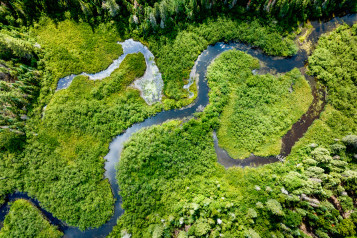Publication
Incentives for CCUS in Alberta

Published January 31, 2023
Carbon capture, utilization and storage ("CCUS") is viewed as the most effective option available to the energy industry to make material reductions in greenhouse gas emissions in the medium term without adversely impacting production. As one half of the carrot and stick approach that governments across Canada have generally adopted on the issue of climate change, incentives related to CCUS projects are critically important to stimulate the nascent CCUS industry, providing a way for project proponents to monetize their investments in CCUS infrastructure and technology. The incentives are generally considered to be "stackable", meaning that the various incentives that can be obtained through different government programs can all be added together to support project economics. Proponents must carefully assess the availability, value and certainty of such incentives over the lifespan of any proposed CCUS project in their financial modelling before reaching a final investment decision.
Government of Canada Incentives
The most significant aspect of the Canadian government's approach to climate change incentives is the refundable investment tax credit ("ITC") for CCUS investments made after January 1, 2022. Announced in the federal budget in March 2022, the ITC is available for investments relating to the geological or concrete storage of CO2 (except for investments in enhanced oil recovery ("EOR")) and for eligible expenses, which exclude feasibility and front-end engineering and design studies, operating costs and equipment that is not dedicated to CCUS activities.[1] The government did however introduce new classes of depreciable property which may include such expenses, as discussed below.
The ITC operates to reduce income taxes by an amount equal to 60% for "eligible capture equipment" used in direct air capture projects; 37.5% for transportation, storage and use equipment; and 50% for all other "eligible capture equipment".[2] To incentivize early investment in CCUS technology, the ITC for CCUS investments will reduce by 50% after 2030, and be eliminated after 2040.[3] The ITC is claimed in the tax year in which eligible costs and expenses are incurred and, because it is refundable, may result in a refund payment from the government if a taxpayer's ITCs exceed taxes that are otherwise payable. Although welcomed by the oil and gas industry, the ITC fell short of industry recommendations for a 75% ITC that would include EOR projects.[4]
Less than six months after being announced, the ITC was overshadowed by similar tax credits included in the U.S. Inflation Reduction Act. That Act expanded the application of the 45Q tax credit in the United States and increased the tax credit available for various CCUS activities, including $85/tonne of CO2 sequestered via geological storage and up to $180/tonne of CO2 sequestered using direct air capture projects.[5] Unlike in Canada, the 45Q credits are available for EOR projects.[6]
Although not an apples-to-apples comparison, the 45Q credits are estimated to equate to about 85% of eligible expenses, which significantly exceeds Canada's ITC.[7] This has raised concerns that investment capital from companies operating in Canada will flow to U.S. rather than Canadian projects, undermining Canada's policy objective. Industry participants had been hoping the federal government would adjust course and level the playing field in North America by increasing the value of the ITC and extending it to EOR in its Fall Economic Statement. However, on November 3, 2022, the Government of Canada declined to commit any additional direct funding to CCUS. Instead, it announced a new Canada Growth Fund, a $15 billion dollar investment fund intended to help attract private investment for emerging technologies including CCUS, hydrogen and biofuels through the use of flexible financial solutions that will mitigate or absorb project risks such as demand, policy, regulatory and execution risk.[8] The Department of Finance Technical Backgrounder suggests that such measures could include debt or equity investments with either higher risk or capped returns, contracts for differences to provide price assurance, or direct offtake agreements.[9] Additional details are scarce at the moment but are expected to be released in the first half of 2023.
In addition to the available ITC and other tax credits, the Government of Canada's 2022 federal budget proposes the creation of a number of new capital cost allowance ("CCA") classes which would allow companies to amortize the capital cost of CCUS investments over their useful life.[10] Notably, the new CCA classes could potentially encompass the capital costs of certain investments that are excluded from the ITC. Capture, transportation and storage equipment will generally be deductible at a rate of 8% on a declining balance basis. Equipment required for using CO2 in an eligible use will be deductible at a rate of 20% on a declining balance basis. These classes of depreciable property will be eligible for enhanced first year depreciation under the existing Accelerated Investment Incentive, which may allow for a full depreciation in the year the equipment becomes available for use.[11] Taxpayers may note that certain equipment is depreciable at different rates depending on the industry in which it is used. For example, assets used in petroleum and natural gas activities falling into Class 41 are generally depreciable at a rate of 25%, whereas similar equipment used for CCUS would be depreciable at the rates discussed above.[12] This discrepancy may, in part, be explained by the additional ITC available to investors in CCUS technology, which is not available to investors in petroleum and natural gas activities.
The 2022 federal budget also proposes the creation of new classes of depreciable property for expenses related to exploration and development for the purpose of CCUS storage. These expenses were excluded from the ITC for CCUS, so the announcement of these new classes should be welcomed by investors. Exploration expenses will be depreciable at a rate of 100% and expenses related to development of CO2 storage will be depreciable at a rate of 30%, both on a declining balance basis.[13]
There are also various grant programs in effect at the federal level. For example, the Net Zero Accelerator (a part of Canada's Strategic Innovation Fund) has allocated $8 billion to support key investments in high emitting sectors, industrial transformation, clean technology and battery development with the aim of reducing existing greenhouse gas emissions in Canada.[14] It recently solicited proposals for investments in high emitting sectors.[15] The Energy Innovation Program has budgeted $319 million over seven years to advance the commercial viability of CCUS across three focus areas: capture, storage and transportation, and utilization.[16] In 2021, 11 projects were selected to receive an aggregate of $50 million for front-end engineering and design studies for large-scale CCUS facilities, one of which was the Canadian oil sands producers' Pathways Alliance initiative.[17]
Alberta Government Incentives
In Alberta, incentives for CCUS are primarily focused around the impact of CCUS activities on reducing emissions rather than directly incentivizing related capital investments.
The starting point for any discussion of Alberta's CCUS incentives is its Technology, Innovation and Emissions Reduction Regulation ("TIER") which regulates facilities that emit more than 100,000 tonnes of CO2e per year.[18] Facilities that are able to reduce emissions below benchmarked levels generate emissions performance credits ("EPCs") that can be sold to other regulated emitters whose facilities have exceeded their allowable emissions.[19] Facilities that exceed their allowable emissions under TIER are required to pay a prescribed fee of $50 per tonne of CO2e for 2022, which will escalate annually to maintain equivalency with the Government of Canada's Output-Based Pricing System regulating large emitters.[20] Fees paid under TIER flow into the Technology Innovation and Emissions Reduction Fund (the "TIER Fund"), which is intended to be used to support investments in emissions reduction projects.
In September 2022, the Government of Alberta announced an intention to put the entire $750 million TIER Fund to work supporting projects that will help industry reduce its CO2 emissions.[21] It allocated $131 million to the Industrial Efficiency, Carbon Capture, Utilization and Storage grant program, which awarded $100 million of TIER funds among seven proposed CCUS projects in November 2021.[22] Other funding from the TIER Fund is distributed through Emissions Reduction Alberta, which in July 2022 allocated a total of $50 million to 11 CCUS projects in Alberta to support preliminary studies as part of the Carbon Capture Kickstart Challenge.[23]
Alberta's TIER also establishes a framework for the generation of emissions offsets for activities that voluntarily reduce emissions.[24] Those emissions offsets can be purchased and submitted for compliance purposes by emitters regulated under TIER. In order to be recognized and registered in the Alberta Emissions Offset Registry, projects that reduce emissions must satisfy the requirements of approved quantification protocols. Protocols specific to both CO2 capture and sequestration in deep saline aquifers and EOR are currently available.[25] Effective January 1, 2023, the Government of Alberta updated TIER to create two additional types of credits relevant to CCUS projects – a sequestration credit and a carbon recognition tonne. An emissions offset project developer can convert an emissions offset into a sequestration credit if the source of the sequestered emissions was a regulated emitting facility. Sequestration credits may be used by regulated emitters to reduce their net emission for TIER compliance, similar to emissions performance credits and emissions offsets. Sequestration credits may also be converted into capture recognition tonnes if they are held by the regulated emitter from which the sequestered emissions originated. Unlike sequestration credits, capture recognition tonnes operate to reduce the total regulated emissions from the regulated emitter[26] and are intended to provide an objective way for regulated emitters to show emissions reductions for ESG and corporate reporting purposes. Both sequestration credits and capture recognition tonnes are also intended to be stackable on top of any federal credits generated under Canada's Clean Fuel Regulations[27].
Unlike the ITC and CCA relating to capital investments, credits relating to emissions reduction can be bought and sold. This means that the ownership of incentives is a critical element to be considered in project agreements for the development of CCUS projects and commercial agreements with large emitters, as multiple parties are likely to seek to benefit from such incentives to support the economics of CCUS investments or reduce their own TIER compliance costs.
An emerging concern for Alberta's emissions reduction credit system is the fact that proponents of many CCUS projects consist of large emitters regulated under TIER. If large emitters make significant investments in CCUS, they will likely generate a considerable number of emissions reduction credits, flooding the market with supply while simultaneously reducing the strong demand for credits once created by those same emitters. The resulting negative impact on price will reduce the value of such credits in the overall incentive matrix available to CCUS projects, and as a result proponents will need value such credits conservatively, well below the natural cap of the prescribed TIER compliance fee.
Conclusion
Although well intentioned and generally welcomed by industry, the framework of CCUS incentives across Canada has become a patchwork quilt of policies that is increasingly fragmented and complex, suffering from three significant issues: the potential for CCUS incentives to change with shifting political winds after every election, uncertainties associated with the future valuation of available emissions reduction credits, and the availability of stronger incentives for CCUS investments in the United States. Taken together, these issues will negatively impact that amount of CCUS investment in Canada. In order to ensure that Canada maximizes the potential benefits of CCUS, it is critical that the federal and provincial governments focus on ways to increase certainty for proponents of these long-life, multi-billion dollar projects and substantively match the incentives available in the U.S. The federal government appears to be taking a step toward more certainty with the financial instruments available through the Canada Growth Fund, in particular with the proposed use of contracts for differences, but it remains to be seen whether Canada's alternative approach to addressing the ITC program's deficiencies relative to the United States will prevent the outflow of CCUS investment capital to the U.S.
[1] Tax Measures: Supplementary Information | Budget 2022
[2] Tax Measures: Supplementary Information | Budget 2022
[3] Government of Canada, Department of Finance (April 7, 2022). Tax measures: Supplementary information: Budget 2022. Tax Measures: Supplementary Information | Budget 2022. Retrieved from https://www.budget.canada.ca/2022/report-rapport/tm-mf-en.html#a3
[4] Profits for oil companies should be invested in climate action: Guilbeault. (May 6, 2022): Daily Oil Bulletin from https://www.dailyoilbulletin.com/article/2022/5/6/profits-for-oil-companies-should-be-invested-in-cl/
[5] The Inflation Reduction Act and Enhanced Oil Recovery (factset.com)
[6] Section 45Q Credit for Carbon Oxide Sequestration – Policies - IEA
[7] Platt, B. (2022, October 13). Carbon capture tax credits: Justin Trudeau wants to catch up with Joe Biden. Bloomberg.com. Retrieved from https://www.bloomberg.com/news/articles/2022-10-13/trudeau-wants-to-catch-up-with-biden-on-clean-energy-tax-credits?leadSource=uverify+wall#xj4y7vzkg
[8] Chapter 2: A Strong, Growing, and Resilient Economy | Budget 2022 (canada.ca)
[9] Technical Backgrounder (Ministry of Finance), Canada Growth Fund: gf-fc-en.pdf (canada.ca)
[10] Class 57 – 8% declining balance basis for capture, transportation, storage, related monitoring and control equipment, related buildings or structures; Class 58 – 20% declining balance basis for use of CO2 in industrial application, related monitoring and control equipment, related buildings and structures; Class 59 – 100% of intangible exploration expenses; and Class 60 – 30% declining balance basis for CCUS development expenses: https://www.ey.com/en_ca/tax/tax-alerts/2022/tax-alert-2022-no-41
[11] Accelerated Investment Incentive - Canada.ca
[12] Capital Cost Allowance – Equipment Used in Petroleum and Natural Gas Activities - Canada.ca
[13] Canada | Status of proposed federal investment tax credit for carbon capture, utilization and storage | EY - Global
[14] Net Zero Accelerator Initiative (canada.ca)
[15] Government of Canada: Strategic Innovation Fund (Net Zero Accelerator) (2022, March 18). Government of Canada, Innovation, Science and Economic Development Canada, Innovation Canada. Retrieved from https://ised-isde.canada.ca/site/strategic-innovation-fund/en/net-zero-accelerator-initiative
[16] Energy Innovation Program - Carbon capture, utilization and storage RD&D Call (nrcan.gc.ca)
[17] Energy Innovation Program – FEED Studies for Carbon capture, utilization and storage (nrcan.gc.ca)
[18] Technology Innovation and Emissions Reduction Regulation | Alberta.ca
[19] Technology Innovation and Emissions Reduction Regulation | Alberta.ca
[20] aep-technology-innovation-and-emissions-reduction-review-discussion-document.pdf (alberta.ca), at page 4.
[21] Alberta empties TIER fund to invest in emission-reducing innovation | CBC News
[22] Industrial Energy Efficiency, Carbon Capture Utilization and Storage | Alberta.ca
[23] Emissions Reduction Alberta (ERA) offers $50 million in funding for technologies that help oil sands meet greenhouse gas emissions limit by 2030 - Emissions Reduction Alberta (eralberta.ca)
[24] Alberta Emission Offset System | Alberta.ca
[25] Alberta Emission Offset System | Alberta.ca
[26] Review of Alberta's Technology Innovation and Emissions Reduction (TIER) Regulation at page 9
[27] Clean Fuel Regulations SOR/2022-140





